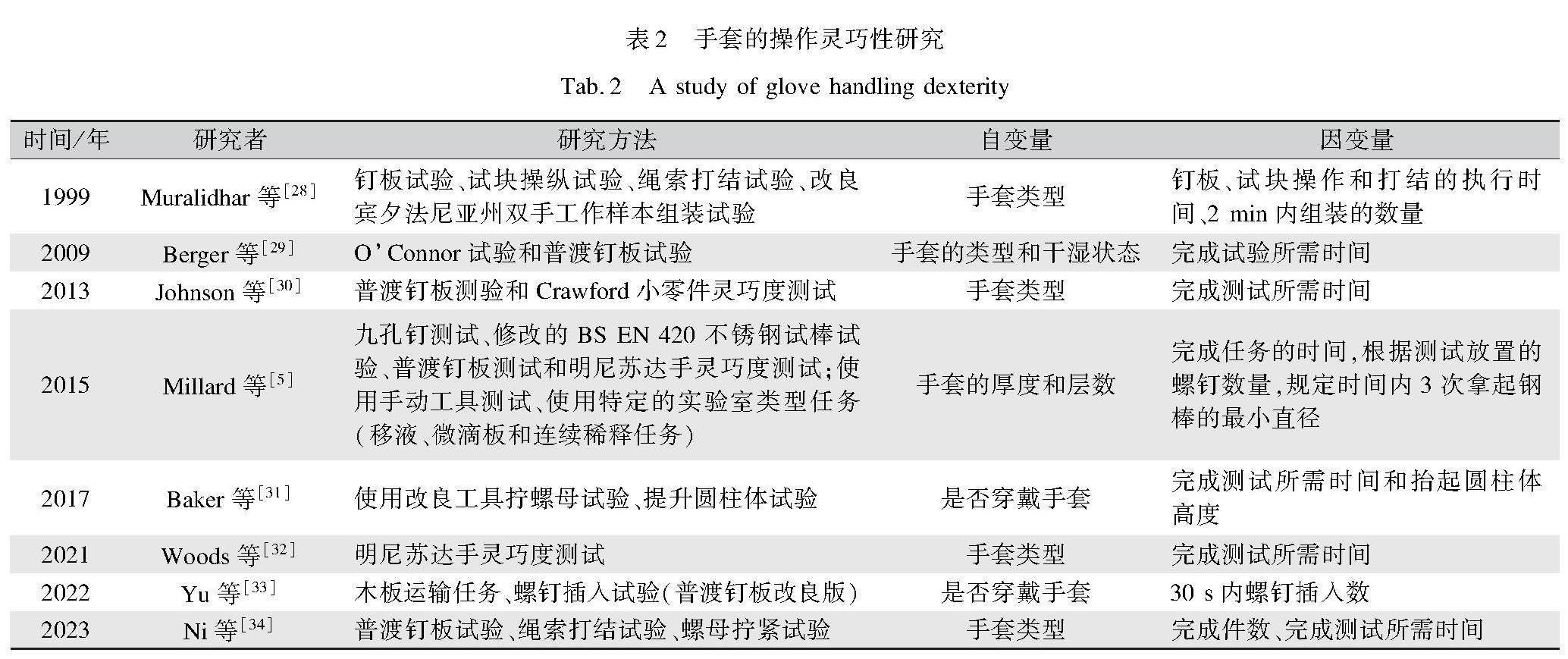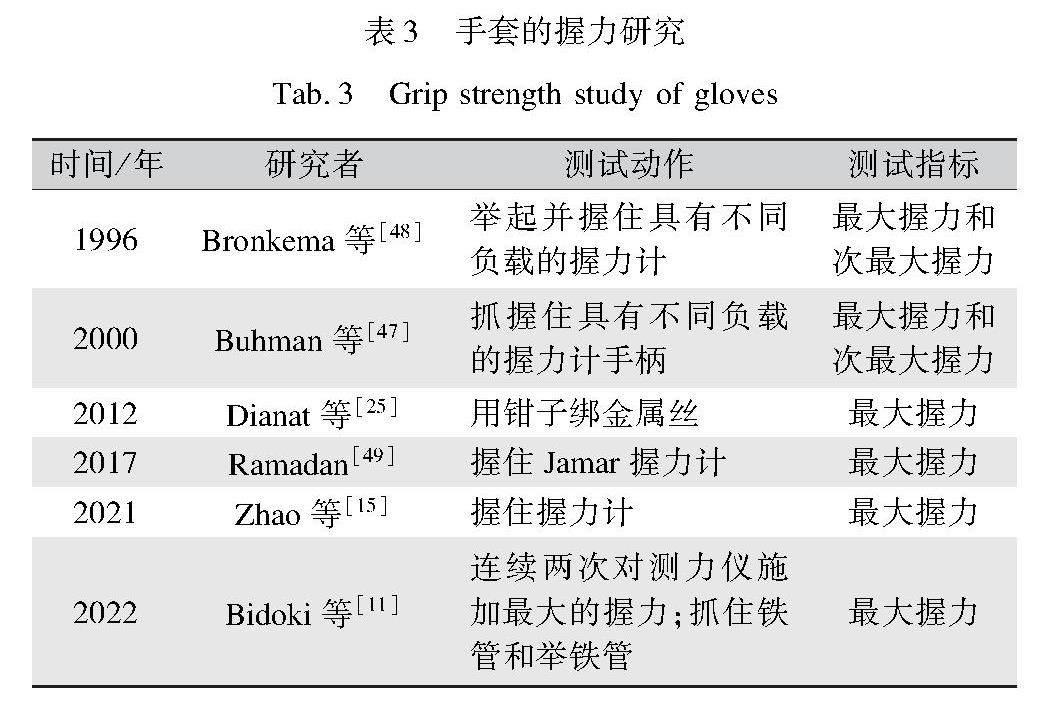防护手套活动性能研究进展
2024-06-17苏冰冰何佳臻陈忠伟何爱芳陈雁
苏冰冰 何佳臻 陈忠伟 何爱芳 陈雁



Research progress on the mobility performance of protective gloves
摘要:
为全面评价防护手套的活动性能,定量分析防护手套对手部活动能力造成的影响,更好地促进防护手套的研发,文章回顾了有关防护手套活动性研究的起源。从防护手套、人体、环境三方面归纳了防护手套活动性能的影响因素,并从运动学和动力学两个层面出发,探讨了佩戴防护手套时手指和手腕活动范围、操作灵巧性、触觉敏锐性、握力、扭矩、肌肉活动和疲劳六个方面的活动性能评价方法。最后提出,未来应建立防护手套活动性能的综合评价体系和评价标准,在虚拟现实/增强现实条件下开展防护手套活动性能的评价研究,模拟真实工况条件以全面揭示防护手套活动性能影响因素,从而提高活动性能评价准确性。
关键词:
防护手套;活动性;操作灵巧性;触觉敏锐性;握力
中图分类号:
TS941.724
文献标志码:
A
文章编号: 1001-7003(2024)06-0069-10
DOI: 10.3969/j.issn.1001-7003.2024.06-.008
收稿日期:
20230923;
修回日期:
20240422
基金项目:
国家自然科学基金项目(51906169);中国博士后科学基金面上项目(2023M033);中国纺织工业联合会科技指导性计划项目(2023020);苏州大学人文社会科学研究一般项目(23XM1009)
作者简介:
苏冰冰(1999),女,硕士研究生,研究方向为功能服装设计与性能评价。通信作者:何佳臻,副教授,jzhe@suda.edu.cn。
手是人类最重要、最灵巧的运动器官,其主要通过抓握、运用手部肌肉力量及手部运动、触觉反馈和运动协调等方式执行任务。同时,手可以保护身体的其他部位免受危险。然而,过度或不当使用会引发手的各种功能障碍或病症。当手部功能受损时,人类身体机能下降程度可达54%。中国产业人口数量庞大、劳动密集、人工作业现象普遍,很多作业需手部操作完成,高强度持续作业易导致手部负荷过重,职业性手损伤现象非常普遍。据不完全统计,手部伤害事故占到了各类工伤事故数量的25%。因此,在众多工业、医疗、实验室等场所内要求必须佩戴防护手套以保护双手免受各种机械(磨损、挤压、切割、断裂、穿刺等)、温度(冷表面和热表面)、辐射(紫外线、红外线、X射线、伽马射线等)、化学(腐蚀性、刺激物、增敏剂等)、生物(感染性病原体)和电气危害等。
目前市场上的防护手套有乳胶手套、丁腈(Nitrile)手套和绝缘手套等类型,其旨在通过防止交叉感染、耐化学腐蚀和绝缘保护等方式为手部提供防护。在设计、制造或选择合适的防护手套时,需要考虑危险类型、使用工具、任务持续时间及需要保护位置(手掌、手指和前臂)等重要因素。除此之外,
还需考虑防护手套的材料类型,如耐热皮革、防水油布、聚氯乙烯、尼龙等;而手套厚度应根据所需的防护水平来选择,如在处理较高电压时,需要佩戴较厚的绝缘防护手套。
防护手套除了能为人体手部提供防护之外,所存在的主要问题之一在于其会对手部的灵巧性和握力等活动性能产生负面影响,使工人戴着手套执行任务变得困难。由于手套对活动性能的阻碍作用,人们往往更喜欢裸手工作。如消防手套较厚、尺寸较宽松,随着消防员戴手套作业时间延长,手部活动次数增多,容易出现手部疲劳程度加大与灵活性下降的问题。提升防护手套的活动性不仅可以充分发挥防护作用,还可以提高工作效率、延缓疲劳感的产生、增加反应速度。防护手套活动性能的研究起源于20世纪60年代,Bradley[1]发现当戴着羊毛手套进行作业时,需要更长的时间才能完成任务。陈守平等[2]分析了航空航天手套活动性能的表征方法,得出可以用握力表征力量、以主观疲劳和行为下降表征疲劳、以形状感知表征触觉。韩龙柱等[3]测试评价了航空航天手套的活动性能,得出温度对航空航天手套活动性能影响显著,且在15.6℃时活动性较佳。目前防护手套活动性能评价已经逐渐建立了一些评价标准,如欧洲标准EN ISO 21420:2020《防护手套——一般要求和测试方法(Protective gloves-General requirements and test methods)》提供了用于测试手套灵巧性能的方法,以确保手套在提供适当保护的同时也能保持手部的活动性能和舒适性。
本文围绕手套的活动性能,首先从防护手套、人体和环境三方面归纳其影响因素,其次从运动学和动力学两个层面出发,针对手指和手腕活动范围、操作灵巧性、触觉敏锐性、握力、扭矩、肌肉活动和疲劳六个方面,对防护手套活动性能的评价方法进行归纳总结。以期研究结果对手套的活动性能评价方法完善及功能性设计提供指导。
1 防护手套活动性能影响因素
1.1 防护手套层面
防护手套厚度和层数是其活动性能的主要影响因素之一[4-6]。Yao等[7]从手部灵巧性和手掌、手指的分布式振动传递性两方面对防振手套的综合性能进行研究。手指区域的材料厚度对活动性能有显著影响,随着手套厚度的增加,手套的活动性能几乎呈线性下降。Gnaneswaran等[8]研究了乳胶手套厚度对灵巧性的影响,让受试者用剪刀沿线剪纸,发现0.83 mm的手套厚度在任务过程中不会对灵巧性产生显著的负面影响,而手套厚度再进一步增加时,灵巧性会受到显著影响。Nelson等[9]研究发现,增厚的手套会降低手的触觉敏感度。Torrens等[10]研究表明,只有戴厚手套或两层手套时,灵巧性才会受到显著影响。Bidoki等[11]研究发现,戴多层防护手套会降低手的触觉灵敏度。此外,他们还对不同设计和层数组合的手套进行了评价,结果表明各区域层的类型、排列和厚度也对防护手套的活动性能有着很大影响。
防护手套材料也是影响其活动性能的主要因素之一。Sawyer等[12]采用普渡钉板测试,测试丁腈手套和乳胶手套两种手套的灵巧度水平。研究发现尽管材料较厚,但与丁腈手套相比,乳胶手套的手指灵巧度高出8.6%。还有研究表明,乳胶手套对最大握力产生的负面影响最小,没有显著影响[13];而由橡胶制成的航天手套的影响最大,最大握力降低65%[14]。Bidoki等[11]研究发现,手套掌区所使用的保护层材料的刚度和可压缩性对扭矩强度有重要影响。
此外,Zhao等[15]指出手套款式结构也是灵巧性的影响因素之一。同时,防护手套的尺寸也是影响其活动性能的主要因素之一。Moore等[13]使用乳胶手套进行普渡钉板测试,发现佩戴错误尺寸的手套会对灵巧度产生负面影响。Kovacs等[16]研究发现,不合适的手套会降低手的握力。
1.2 人体层面
Francis等[17]证明了专业人员所拥有的技能熟练程度是手套灵巧性的影响因素之一。在钉板测试中,相较于经验丰富的外科医生而言,学生佩戴手套时完成测试过程中掉落下的钉子更多,灵巧性下降。为此,为了准确反映钉板测试结果,建议测验招募的受试者都应该具有相同的经验水平,这是手套活动性能测试中应该考虑的重要因素。
同时,手部运动的持续时间、重复运动的间隔休息时间和身体位置或姿势等因素都会对握力的测量产生影响。受试者进行测量时所采取的姿势会影响手部力量的测量,因此在评估过程中应控制其身体的姿势不变。测量过程中对受试者的表现进行视觉反馈或口头鼓励也会对受试者所施加的力产生影响。此外,扭矩强度受到特定任务的背景、任务执行的具体方法和工具手柄的性质差异影响。
1.3 环境层面
Tian等[18]研究了航天手套在低温环境下的灵巧性,发现灵巧性随温度降低而下降。Orysiak等[19]在三种不同温度下评价手部灵巧性,研究表明环境温度对手部灵巧性有影响。Zander等[20]研究发现,在低压下温度对手的灵巧性没有影响,但在高压下温度对手的灵巧性产生影响。丁立等[21]研究表明,有压时握力是无压时的70%左右。
整体而言,防护手套、人体和环境三个层面都会对佩戴手套时的手部活动性能产生影响,通过综合考虑上述因素对防护手套活动性能的影响,并不断进行手套材质和设计的创新和改进,可以提高防护手套的活动性能,从而为工人提供更好的保护和舒适性。
2 防护手套活动性能评价方法
基于运动生物力学的基本原理,本文分别从运动学和动力学两层面阐述防护手套活动性能的评价方法。利用运动学指标描述手部运动的规律,评价穿戴手套后手部的可活动性;利用动力学指标解释手部运动规律的机制,从力的角度探讨穿戴手套后手部活动表象的形成原理。
2.1 运动学层面
佩戴手套后,手部在空间内的运动能力会受到影响,为此采用运动学层面的测评可以获取手部活动规律的表象特征,进而对防护手套的活动性能进行评价。防护手套运动学层面的测评主要包括手指和手腕活动范围测评、操作灵巧性测评、触觉敏锐性测评三部分。
2.1.1 手指和手腕活动范围
手指的掌指关节、近端指间关节和远端指间关节的活动范围分别为19°~71°、23°~87°和10°~64°,手腕复杂的关节使其能够进行屈伸运动和尺侧、桡侧偏离等活动。手指和手腕的活动范围是指在关节作用下手指和手腕能够自由活动的角度。表1列出了手指和手腕活动范围的相关研究。根据表1中测试设备的类型可以将手指和手腕活动范围的测试分为静态和动态测试。其中,静态测试时利用测角仪或数码相机,记录手指或腕部至最大活动状态时的静态指间角度或腕关节角度;动态测试时利用摄影机对手部的连续作业进行动态跟踪,除了记录关节姿势外,还可以通过视频处理软件建立运动坐标,从而量化关节运动角度。动态测试在测试手指和手腕活动范围时拥有可靠性强、重复性良好的优点,与静态测试相比,动态测试较静态测试更能反映实际的连续运动状态。有研究指出,与裸手相比,戴手套抑制了手指和手腕的活动范围[17-22]。此外,Oscari等[22]设计了远程触觉虚拟系统,可以用于远程评估手部的活动范围。该系统通过连接两个触觉设备(主设备和从设备),实现主从设备之间的双向交互。受试者将手放入与设备相连的辅助矫形器中移动手指,测试者可以通过与主设备相连接的假手远程测量受试者手部的活动范围。
2.1.2 操作灵巧性
手的灵活性是由手臂、手掌和手指的活动范围及手掌和手指操作能力决定的运动技能。针对手套的灵巧性测试,已经建立了部分相关测试标准,如BS 8469:2007《消防用个人防护设备——人类工效学性能和兼容性评估——要求和试验方法》要求在规定动作(如放置钉子到钉板内)中比较佩戴手套状态和裸手状态下手部的操作灵巧性;EN ISO 21420中描述了防护手套灵巧性的测试方法,佩戴手套拾取五种不同直径的不锈钢试棒,规定所拾取钢棒直径不得大于11 mm。此外,很多研究还在致力于丰富和完善灵巧性测试方法,如表2[5,28-34]所示。这些研究通过采用Bennett手动工具灵巧度测试(美国国家消防协会(NFPA)消防手套标准中使用)、明尼苏达手灵巧度测试、OConnor灵巧度测试、宾夕法尼亚州双手工作样本组装测试、绳索打结测试、滑车操纵等多项手部动作模拟测试,实现对手部操作灵巧性的评估。其中,明尼苏达手灵巧度测试要求受试者从测试板孔内拿取圆柱棋,左右手各拿起一个,同时翻转并放入测试板的孔内[28];克劳福德小零件灵巧性测试[30]需要使用镊子放置引脚,其适用于评估更为精细活动的灵巧性。上述测试涉及单手或双手灵巧性、单根手指或全手灵巧度的测试,其选择取决于研究的条件和目的。例如,Bennett手动工具灵巧度测试最能用于表征整个手的灵巧度,因为它既涉及精细手指灵巧性,也涉及全手灵巧度,而且是双手测试。但该测试所需时间长且螺栓的拧紧程度无法一致。相较于Bennett手动工具灵巧度测试,普渡钉板测试效率高且成本低,更适用于一般防护手套的灵巧性评价,但其主要用于评价手指执行复杂任务的灵巧性,而非全手的灵巧性。
由表2可以看出,通常将完成测试所需的时间或者效率作为操作灵巧性的衡量指标。然而,由Tiffin等[35]描述的普渡钉板测试旨在通过测量双手和单手分别在规定时间内可以将多少钉子放入板中来评估总灵巧度。
2.1.3 触觉敏锐性
触觉敏锐性是指通过触摸感知的方式准确确定物体的纹理、形状、大小和方向的能力。实际上,佩戴手套会对触觉敏锐性产生负面影响[11,20,36]。触觉敏锐性测试可分为三种类型,即力量感知觉、空间感知觉和形状或纹理感知觉。其中,力量感知觉测试和形状或纹理辨别测试具有标准化的测试流程,且被证实是有效且可靠的。
在力量感知觉方面,单丝测试是最常用的测试方法。这项测试要求受试者蒙上双眼,将不同直径的细丝压入受试者的手指,当细丝开始弯曲时,停止施加压力并询问受试者是否有接触感。测试从最细的单丝开始,然后逐渐增加细丝的直径,直到受试者反馈产生了接触感,再同步记录细丝的直径。该测试的局限性在于按压不同直径细丝的压力不同,无法控制与细丝接触的力。Yu等[36]运用单丝测试评估手的触觉敏锐性,研究发现粗丝较细丝需要更大的力使其弯曲。Tiefenthaler等[37]使用Semmes-Weinstein单丝测试,研究了乳胶检查手套和手术手套对手的力量感知觉的影响。此外,陈守平等[2]测量了受试者佩戴手套对钢球质量变化的感知,分析了手套对力量感知能力的影响。此外,振动也成了一种触觉敏锐性评价量化的方法。Carre等[38]使用振动平台测量佩戴天然乳胶手套时手的触觉敏锐性,得出与不戴手套相比,戴手套时手的触感降低。
两点辨别测试是对空间感知觉的测试,测量同时接触皮肤的两点可以彼此区分的最小距离。但两点辨别测试无法控制所施加力的大小,为此受试者可能会根据力度不同来辨别测试点的数量,从而降低了试验的有效性。Fry等[39]研究表明,佩戴手套不会妨碍两个不同点的距离辨识。而其他研究发现,手套会对两点位置辨别的最小距离产生负面影响。Bidoki等[11]使用游标卡尺获得了受试者佩戴手套后的触觉敏锐性。卡尺的两端放置于受试者的手掌或手指上,要求受试者感受并识别卡尺的尖端数量,记录受试者感受到两个尖端的最小距离。研究发现,佩戴手套会降低手的空间感知觉,且手指的力量感知觉优于手掌的力量感知觉。
粗糙度判别测试是对形状或纹理感知觉的测试。该类测试要求参与者识别刺激物的不同凹凸程度或粗糙度。Phillips等[40]研究中让受试者佩戴眼罩,评估其匹配相同纹理的错误率、对齐金属螺柱面的错误率、识别物体的时间及匹配木质物和图片的错误率,进而实现对手套触觉敏锐性的评价。Zander等[20]提出了基于改良盲文测试的触觉敏锐性评价方法,测试过程中受试者必须通过触摸来感知和识别盲文,记录4 min内正确识别的字符总数作为评价标尺。砂纸感知测试也是粗糙度判别测试的一种。Mylon等[41]研究表明,受试者戴着手套在砂纸上移动时可以感知粗糙度的变化,但在静态按压砂纸时不能分辨砂纸的粗糙程度。Nelson等[9]探究了手套厚度对触觉感知的影响,测试中要求受试者蒙上眼睛并佩戴不同厚度的手套,分别测量拿起正确粗糙度砂纸的时间和伸手拿取规定直径管件的时间。此外,Mylon等[42]基于3D打印技术设计了用于纹理感知觉评估的刺激材料。用3D打印机将100~600 μm的丘疹打印在固定于平板上的柔软橡胶状薄片之上,要求受试者用手指触摸薄片,记录可识别的丘疹尺寸。但随试验时间的增加,硅胶会变硬,从而难以识别出丘疹,且受试者手指平行或垂直平板触摸薄片会导致不同的试验结果。Gnaneswaran等[8]进行了类似的试验,在海绵块上用胶水制作了三排印痕,要求受试者蒙上双眼识别胶点数量。
随着数字技术的发展,在触觉敏锐性评价中研究人员逐渐引入了虚拟现实系统。如Dahan等[43]设计了基于触觉的虚拟现实系统,可用于评价力量感知觉和纹理感知觉,并验证了其与当前传统触觉敏感性评估的一致性。
2.2 动力学层面
佩戴手套后,手部需要更大程度地调动肌肉系统以满足活动需求,进而产生一系列的动力学响应。因此,可借助佩戴手套后的肌肉功能状态来探究手部应对防护手套的动力学响应机制,并评价防护手套的活动性能。防护手套动力学层面的测评主要包括握力、扭矩、肌肉活动与疲劳测评三部分。
2.2.1 握 力
握力是一种全手参与的动作,它涉及手部所有的手指和
掌骨,各自以不同程度施加力量。相较于手指的捏力和拧力,握力需要更多肌肉群的协同作用。因此,握力被视为评价手部力量的代表性指标。握力作业在航天及地面活动的应用极为广泛。此外,罗恢育等[44]提出了舒适握力的概念,即特定工况下人体能轻松达到且较长时间保持手部不易产生疲劳的握力值。Park等[45]探究了机械感受器在力量控制中的作用及手套对握力的影响。
握力的测量装置有各种类型的手握式测功机,Jamar握力计是测量手部力量最常用的工具之一。然而,近年来也开发了气压式(灯泡型)握力计等其他类型的握力计。研究表明,气压式握力计在测量手部握力方面具有更高的精准性。相较于传统的Jamar握力计,手部较大的人使用气压式握力计更加容易和舒适。此外,气压式握力计比Jamar握力计更便宜,Appendino等[46]使用气压式握力计研究了佩戴航天手套对手部力量的影响,但除此之外很少有其他研究使用这种握力计来测量佩戴手套时的手部力量。因此,气压式握力计在手套活动性评估方面的有效性有待进一步验证。
ISO 15383—2001《消防员用防护手套——实验室试验法和性能要求》等级中描述了消防手套握力的测试方法,比较戴手套和裸手拉动干、湿绳索的能力,规定戴手套与裸手的拉重力比不应小于80%。此外,针对手套的握力代表性研究(表3),可以看出,进行握力评价时,大多数研究选择最大握力作
为测试指标,同时由于很多握力作业需要次最大握力的参与,因此少数研究也将次最大握力作为评价指标[47]。次最大握力往往由任务本身决定,受试者需要保持低于最大握力的力,但是如果无法准确施加次最大握力,试验结果易偏离预期的结果。研究表明,手套会对最大握力和次最大握力产生负面影响。考虑到维持最大握力的测量时间为3 s,因此如果进行少次测量,在两次最大握力的测试中间应至少有30 s的休息时间;如果进行重复测量,则休息间隔时间必须延长至15 min以上,以避免受试者在疲劳状态下进行试验。
2.2.2 扭 矩
扭矩是使物体发生转动的一种特殊的力矩。与手套会对握力产生负面影响不同,手套对扭矩的影响尚不确定。Jenkins等[50]研究了佩戴航天手套时的扭矩,发现佩戴手套旋转小旋钮时扭矩较裸手时降低,旋转大旋钮时则相反。
关于手套扭矩的相关研究如表4所示。扭矩传感器是这些研究中常用于测量扭矩强度的设备,称重传感器和应变计也有少量应用。如Woods等[32]使用称重传感器测量佩戴手套使用螺丝刀时的扭矩。
最常见的评估扭矩时的作业任务包括使用螺丝刀、扳手等手动工具,拧动摩托车油门,转动汽车方向盘,拧动瓶盖,操作旋钮,打开阀门,拨动圆形电连接器[51]。Adams等[52]通过拨动圆形电连接器发现戴手套提高了扭矩。Mcgorry[53]设计了一种仪表化的工具手柄来评价手套的扭矩。Bidoki等[11]提出用打开阀门的时间来评价防护手套的扭矩能力。Shih等[51]提出手柄作为人实现扭矩动作的重要部件,其形状及尺寸对手套的扭矩能力有影响。
由表4可以看出,测试动作不同,手套对扭矩的影响也会有差异。因此在开展扭矩测试时,需要根据手套的实际使用条件,尽可能真实地模拟手部的操作动作,进而准确评价防护手套对手部扭矩的影响。
2.2.3 肌肉活动和疲劳
EMG信号信息可用于研究力和力矩(生物力学方法)或肌肉激活和疲劳(生理学方法)。在进行电生理测量之前,需要将电极放置在肌肉上,并将手套穿戴在手上。表5列出了手套对肌肉活动的研究,并且详细总结了电极的放置位置。通过给手部施加一定的刺激,如让受试者握住物体或挥动手臂,记录手部肌肉的电位变化。这些信号可以通过放大器和数据采集系统进行记录和分析。
Mittal等[54]和Kovacs等[16]使用肌电图测量肌肉激活水平,研究结果表明,佩戴手套对肌肉活动水平没有显著影响。然而,Wells等[6]和Dianat等[25]研究发现佩戴手套时肌肉活动水平增加。其中,Dianat等[25]利用钳子绑金属丝的任务,研究了手套对手指和手腕的活动性能、触觉敏锐性、握力、扭矩、肌肉活动和疲劳五个性能的影响,试验流程如图1所示。
OHara等[14]使用EMG的中值频率表征肌肉疲劳,结果表明手套会引起手指和拇指屈肌及腕屈肌的疲劳。Chang等[58]测试了达到最大自愿收缩(Maximum Voluntary Contraction,MVC)所需的时间变化和最大耐力时间指数,结果表示戴手套和增加手套厚度比裸手更容易导致疲劳。此外,陈守平等[2]使用疲劳计测出戴手套比裸手更易产生疲劳。
肌电图测量可以提供内部肌肉负荷和疲劳信息,并进行动态测量,此外其也具备安全、简单、无创的特点。但是需注意,肌电测试所使用的电极通常具有一定的体积,若佩戴手套时将电极直接放置于手掌或手腕处肌肉,则电极会对手部活动产生机械干扰,在评估手套活动性时(表5),将电极均放置于手臂肌肉,少数还涉及胸部与背部肌肉。
3 结 语
本文首先介绍了防护手套的使用场景及其活动性能的重要性,其次阐明了防护手套活动性能的影响因素,最后从运动
学和动力学两个层面出发,针对手指和手腕活动范围、操作灵巧性、触觉敏锐性、握力、扭矩、肌肉活动和疲劳六个方面分析了防护手套活动性能的评价方法。防护手套活动性能研究体
现了以人为本的研究思路,虽然目前已有部分研究,但仍缺乏综合考虑“人体—服装—环境”的系统评价方法。在今后的研究中,应全面考虑防护手套使用的实际任务类型及使用时间,建立完善的防护手套活动性能评价体系。
1) 建立防护手套活动性能的综合评价体系和评价标准。随着对作业装备安全和舒适性要求的不断提高,防护手套活动性能的评价方法和相关标准也在不断发展。目前针对防护手套的操作灵巧性和握力评价研究方法已经成熟,并且已经建立了相关测试标准,如BS 8469、EN ISO 21420和ISO 15383—2001,然而其他几项活动性能的标准建设工作相对空白。此外,防护手套活动性能的影响因素较多,需对影响防护手套活动性能的各因素进行综合研究。多源信息融合的本质是模拟大脑综合分析信息的能力,将不同空间或时间获取的多个来源的不同信息进行不同抽象层次的集成,从而得到更精确和可靠的信息或推论。基于多源信息融合的可靠性综合评价方法,实现对防护手套的活动性能进行全面、客观的综合评价,同时建立手套活动性能的综合评价体系,并完善相关测试标准。
2) 虚拟现实/增强现实仿真条件下防护手套的评价研究。基于虚拟现实/增强现实技术,开发能够仿真受试者手部运动并向其提供沉浸式虚拟仿真场景的仿真系统。通过建立模型,模拟手套与外界环境的交互过程,评估防护手套在不同作业任务中的活动性能。将虚拟现实/增强现实技术与防护手套活动性能评价相结合可提高评价效率和准确性。这些进展将为未来防护手套的研发和改进提供指导和创新的方向。
参考文献:
[1]BRADLEY J V. Effect of gloves on control operation time[J]. Human Factors, 1969, 11(1): 13-20.
[2]陈守平, 丁立, 杨锋, 等. 基于舱外航天服手套基础性工效评价的人体力学指标优选研究[J]. 航天医学与医学工程, 2006, 19(2): 106-110.
CHEN S P, DING L, YANG F, et al. Study on index optimization of human-mechanics based on basic ergonomic evaluation of spacesuit gloves[J]. Space Medicine & Medical Engineering, 2006, 19(2): 106-110.
[3]韩龙柱, 袁修干, 丁立, 等. 3种温度标准下的舱外航天服手套的工效评价试验研究[J]. 航空学报, 2005, 26(6): 665-669.
HAN L Z, YUAN X G, DING L, et al. Experimental investigations of work efficiency evaluation of EVA spacesuit glove under three temperature standards[J]. Acta Aeronautica et Astronautica Sinica, 2005, 26(6): 665-669.
[4]SOSA E M, WOODS S, POWERS S, et al. Assessing the impact of industrial glove use on perceived hand dexterity, function, and strength[J]. Applied Ergonomics, 2024, 114: 104134.
[5]MILLARD C E, VAUGHAN N P. Assessment of protective gloves for use with airfed suits[J]. The Annals of Occupational Hygiene, 2015, 59(8): 1022-1033.
[6]WELLS R, HUNT S, HURLEY K, et al. Laboratory assessment of the effect of heavy rubber glove thickness and sizing on effort, performance and comfort[J]. International Journal of Industrial Ergonomics, 2010, 40(4): 386-391.
[7]YAO Y M, RAKHEJA S, MARCOTTE P. Distributed vibration isolation and manual dexterity of anti-vibration gloves: Is there a correlation?[J]. Ergonomics, 2020, 63(6): 735-755.
[8]GNANESWARAN V, MUDHUNURI B, BISHU R R. A study of latex and vinyl gloves: Performance versus allergy protection properties[J]. International Journal of Industrial Ergonomics, 2008, 38(2): 171-181.
[9]NELSON J B, MITAL A. An ergonomic evaluation of dexterity and tactility with increase in examination surgical glove thickness[J]. Ergonomics, 1995, 38(4): 723-733.
[10]TORRENS G E, NEWMAN A. The evaluation of gloved and ungloved hands[J]. Contemporary Ergonomics, 2000: 301-305.
[11]BIDOKI F Z, EZAZSHAHABI N, MOUSAZADEGAN F, et al. Objective and subjective evaluation of various aspects of hand performance considering protective gloves constructional parameters[J]. Journal of Industrial Textiles, 2022, 51(4): 6533-6562.
[12]SAWYER J, BENNETT A. Comparing the level of dexterity offered by latex and nitrile safeskin gloves[J]. The Annals of Occupational Hygiene, 2006, 50(3): 289-296.
[13]MOORE B J, SOLIPURAM S R, RILEY M W. The effects of latex examination gloves on hand function: A pilot study[J]. Proceedings of the Human Factors and Ergonomics Society Annual Meeting, 1995, 39(10): 582-585.
[14]OHARA J M. The effect of pressure suit gloves on hand performance[J]. Proceedings of the Human Factors Society Annual Meeting, 1989, 33(2): 139-143.
[15]ZHAO C J, LI K W, YI C N. Assessments of work gloves in terms of the strengths of hand grip, one-handed carrying, and leg lifting[J]. Applied Sciences, 2021, 11(18): 8294.
[16]KOVACS K, SPLITTSTOESSER R, MARONITIS A, et al. Grip force and muscle activity differences due to glove type[J]. AIHA Journal, 2002, 63(3): 269-274.
[17]FRANCIS N K, HANNA G B, CRESSWELL A B, et al. The performance of master surgeons on standard aptitude testing[J]. The American Journal of Surgery, 2001, 182(1): 30-33.
[18]TIAN Y S, ZHANG H B, WANG L, et al. Effects of EVA glove on hand dexterity at low temperature and low pressure[J]. Applied Ergonomics, 2018, 70: 98-103.
[19]ORYSIAK J, MLYNARCZYK M, IRZMANSKA E. The Impact of protective gloves on manual dexterity in cold environments: A pilot study[J]. International Journal of Environmental Research and Public Health, 2022, 19(3): 1637.
[20]ZANDER J, MORRISON J. Effects of pressure, cold and gloves on hand skin temperature and manual performance of divers[J]. European Journal of Applied Physiology, 2008, 104(2): 237-244.
[21]丁立, 杨锋, 杨春信, 等. 舱外航天服手套的工效问题[J]. 北京航空航天大学学报, 2005, 31(4): 416-420.
DING L, YANG F, YANG C X, et al. Ergonomics implications of extravehicular activity spacesuit glove[J]. Journal of Beijing University of Aeronautics and Astronautics, 2005, 31(4): 416-420.
[22]OSCARI F, OBOE R, ALBASINI O A D, et al. Design and construction of a bilateral haptic system for the remote assessment of the stiffness and range of motion of the hand[J]. Sensors, 2016, 16(10): 1633.
[23]BELLINGAR T A, SLOCUM A C. Effect of protective gloves on hand movement: An exploratory-study[J]. Applied Ergonomics, 1993, 24(4): 244-250.
[24]陈守平, 张琳, 丁立, 等. 基于工效评价的手动作业活动范围研究[J]. 航天医学与医学工程, 2007, 20(1): 68-71.
CHEN S P, ZHANG L, DING L, et al. Study on range of motion of manual performance for ergonomics evaluation[J]. Space Medicine & Medical Engineering, 2007, 20(1): 68-71.
[25]DIANAT I, HASLEGRAVE C M, STEDMON A W. Using pliers in assembly work: Short and long task duration effects of gloves on hand performance capabilities and subjective assessments of discomfort and ease of tool manipulation[J]. Applied Ergonomics, 2012, 43(2): 413-423.
[26]YU A, YICK K L, NG S P, et al. The effect of pressure and fabrication of pressure therapy gloves on hand sensitivity and dexterity[J]. Journal of Burn Care & Research, 2015, 36(3): 162-175.
[27]CORREIA C, NUCKOLS K, WAGNER D, et al. Improving grasp function after spinal cord injury with a soft robotic glove[J]. IEEE Transactions on Neural Systems and Rehabilitation Engineering, 2020, 28(6): 1407-1415.
[28]MURALIDHAR A, BISHU R R, HALLBECK M S. The development and evaluation of an ergonomic glove[J]. Applied Ergonomics, 1999, 30(6): 555-563.
[29]BERGER M A M, KRUL A J, DAANEN H A M. Task specificity of finger dexterity tests[J]. Applied Ergonomics, 2009, 40(1): 145-147.
[30]JOHNSON R L, SMITH H M, DUNCAN C M, et al. Factors that influence the selection of sterile glove brand: A randomized controlled trial evaluating the performance and cost of gloves[J]. Canadian Journal of Anesthesia, 2013, 60(7): 700-708.
[31]BARKER R L, ROSS K A, ANDREWS J, et al. Comparative studies on standard and new test methods for evaluating the effects of structural firefighting gloves on hand dexterity[J]. Textile Research Journal, 2017, 87(3): 270-284.
[32]WOODS S, SOSA E M, KUROWSKI-BURT A, et al. Effects of wearing of metacarpal gloves on hand dexterity, function, and perceived comfort: A pilot study[J]. Applied Ergonomics, 2021, 97: 103538.
[33]YU A, SUKIGARA S. Evaluation of the design and materials of anti-vibration gloves: Impact on hand dexterity and forearm muscle activity[J]. Applied Ergonomics, 2022, 98: 103572.
[34]NI J M, XIAO P, LI B Y. Effects of firefighting gloves styles on manual performance[J]. International Journal of Occupational Safety and Ergonomics, 2023, 29(4): 1532-1541.
[35]TIFFIN J, ASHER E J. The purdue pegboard: Norms and studies of reliability and validity[J]. Journal of Applied Psychology, 1948, 32(3): 234-247.
[36]YU A, YICK K L, NG S P, et al. Case study on the effects of fit and material of sports gloves on hand performance[J]. Applied Ergonomics, 2019, 75: 17-26.
[37]TIEFENTHALER W, GIMPL S, WECHSELBERGER G, et al. Touch sensitivity with sterile standard surgical gloves and single-use protective gloves[J]. Anaesthesia, 2006, 61(10): 959-961.
[38]CARRE M J, TAN S K, MYLON P T, et al. Influence of medical gloves on fingerpad friction and feel[J]. Wear, 2017, 376/377: 324-328.
[39]FRY D E, HARRIS W E, KOHNKE E N, et al. Influence of double-gloving on manual dexterity and tactile sensation of surgeons[J]. Journal of the American College of Surgeons, 2010, 210(3): 325-330.
[40]PHILLIPS A M, BIRCH N C, RIBBANS W J. Protective gloves for use in high-risk patients: How much do they affect the dexterity of the surgeon?[J]. Annals of the Royal College of Surgeons of England, 1997, 79(2): 124-127.
[41]MYLON P T, BUCKLEY-JOHNSTONE L, LEWIS R, et al. Factors influencing the perception of roughness in manual exploration: Do medical gloves reduce cutaneous sensibility?[J]. Proceedings of the Institution of Mechanical Engineers, Part J: Journal of Engineering Tribology, 2015, 229(3): 273-284.
[42]MYLON P, CARRE M J, MARTIN N, et al. How do gloves affect cutaneous sensibility in medical practice? Two new applied tests[J]. Proceedings of the Institution of Mechanical Engineers, Part H: Journal of Engineering in Medicine, 2017, 231(1): 28-39.
[43]DAHAN H, STERN H, BITAN N, et al. Construction of a haptic-based virtual reality evaluation of discrimination of stiffness and texture[J]. Cogent Engineering, 2022, 9(1): 2105556.
[44]罗恢育, 刘畅, 田寅生, 等. 基于中国成年人的舒适握力与最大握力研究[J]. 航天医学与医学工程, 2018, 31(3): 336-340.
LUO H Y, LIU C, TIAN Y S, et al. Study on comfortable and maximum grip strength in Chinese adults[J]. Space Medicine & Medical Engineering, 2018, 31(3): 336-340.
[45]PARK S B, DAVARE M, FALLA M, et al. Fast-adapting mechanoreceptors are important for force control in precision grip but not for sensorimotor memory[J]. Journal of Neurophysiology, 2016, 115(6): 3156-3161.
[46]APPENDINO S, BATTEZZATO A, CHEN F C, et al. Effects of EVA spacesuit glove on grasping and pinching tasks[J]. Acta Astronautica, 2014, 96: 151-158.
[47]BUHMAN D C, CHERRY J A, BRONKEMA O L, et al. Effects of glove, orientation, pressure, load, and handle on submaximal grasp force[J]. International Journal of Industrial Ergonomics, 2000, 25(3): 247-256.
[48]BRONKEMA O L, BISHU R R. The effects of glove frictional characteristics and load on grasp force and grasp control[J]. 1996, 40(13): 702-706.
[49]RAMADAN M Z. The effects of industrial protective gloves and hand skin temperatures on hand grip strength and discomfort rating[J]. International Journal of Environmental Research and Public Health, 2017, 14(12): 1506.
[50]JENKINS W L. The superiority of gloved operation of small control knobs[J]. Journal of Applied Psychology, 1958, 42(2): 97-98.
[51]SHIH Y C, WANG M J J. Hand/tool interface effects on human torque capacity[J]. International Journal of Industrial Ergonomics, 1996, 18(2/3): 205-213.
[52]ADAMS S K, PETERSON P J. Maximum voluntary hand grip torque for circular electrical connectors[J]. Human Factors, 1988, 30(6): 733-745.
[53]MCGORRY R W. A system for the measurement of grip forces and applied moments during hand tool use[J]. Applied Ergonomics, 2001, 32(3): 271-279.
[54]MITAL A, KUO T, FAARD H F. A quantitative evaluation of gloves used with non-powered hand tools in routine maintenance tasks[J]. Ergonomics, 1994, 37(2): 333-343.
[55]TSAOUSIDIS N, FREIVALDS A. Effects of gloves on maximum force and the rate of force development in pinch, wrist flexion and grip[J]. International Journal of Industrial Ergonomics, 1998, 21(5): 353-360.
[56]IMRHAN S N, FARAHMAND K. Male torque strength in simulated oil rig tasks: The effects of grease-smeared gloves and handle length, diameter and orientation[J]. Applied Ergonomics, 1999, 30(5): 455-462.
[57]CLAUDON L. Influence on grip of knife handle surface characteristics and wearing protective gloves[J]. Applied Ergonomics, 2006, 37(6): 729-735.
[58]CHANG C H, SHIH Y C. The effects of glove thickness and work load on female hand performance and fatigue during a infrequent high-intensity gripping task[J]. Applied Ergonomics, 2007, 38(3): 317-324.
[59]HUR P, MOTAWAR B, SEO N J. Muscular responses to handle perturbation with different glove condition[J]. Journal of Electromyography and Kinesiology, 2014, 24(1): 159-164.
Research progress on the mobility performance of protective gloves
ZHANG Chi, WANG Xiangrong
SU Bingbing1, HE Jiazhen1,2, CHEN Zhongwei2, HE Aifang2, CHEN Yan1
(1.College of Textile and Clothing Engineering, Soochow University, Suzhou 215021, China;2.Hengyuanxiang (Group) Co., Ltd., Shanghai 200021, China)
Abstract:
To comprehensively evaluate the mobility performance of protective gloves, quantitatively analyze the effects caused by protective gloves on hand mobility, and better promote the research and development of protective gloves, relevant studies on the mobility of protective gloves are reviewed. The research on the mobility performance of protective gloves originated in the 1960s, when researchers found that it took longer to complete tasks when working with wool gloves.
The influencing factors of the activity performance of protective gloves were summarized from three aspects: protective gloves, human body, and environment. In terms of the influence of protective gloves, the thickness, number of layers, and material of protective gloves are the main factors influencing their activity performance. Specifically, with the increase of glove thickness, the activity performance of the gloves decreases almost linearly; latex gloves have the smallest negative impact on the maximum grip strength, with no significant effect, while aerospace gloves made of rubber have the greatest impact, with a 65% reduction in the maximum grip strength. Furthermore, glove style construction and size are also an influence on dexterity, with ill-fitting gloves reducing hand grip strength. In terms of human influence, the subjects experience level is an important factor affecting the glove activity performance. For this reason, the experiment requires that the subjects should all have the same experience level. Also, the duration of the hand movement, the rest time between repetitive motions and the body position or posture are all factors that will have an effect on the grip strength measurements. Additionally, torque strength is influenced by differences in the context of a particular task, the specific method of task performance and the nature of the tool handle. In terms of environmental influences, studies have shown that temperature and air pressure in the environment can have an effect on dexterity.
From the kinematic level, the method of evaluating the activity performance in terms of the range of motion of fingers and wrists, maneuvering dexterity, and tactile acuity in wearing protective gloves was explored. Kinematic indicators were utilized to describe the laws of hand movement and evaluate the mobility of the hand after peoples wearing gloves. The range of motion of the fingers and wrist refers to the angle at which the fingers and wrist can move freely under the action of the joints. And the test method is divided into static and dynamic tests, of which the static test utilizes an electrical goniometer or a digital camera to record the static interphalangeal angle or the angle of the wrist joint when the finger or wrist reaches the maximum activity state; the dynamic test utilizes the camera to dynamically track the hands continuous operation. In addition to recording joint postures, motion coordinates can also be established by video processing software to quantify joint motion angles. The study noted that wearing gloves inhibits the range of motion of the fingers and wrist compared to bare hands. Hand dexterity is a motor skill determined by the range of motion of the arm, palm, and fingers as well as the ability to manipulate the hand and fingers. Hand manipulation dexterity is assessed by using the Bennett Hand Tool Dexterity Test, the Minnesota Hand Dexterity Test, the OConnor Dexterity Test, the Pennsylvania Two Handed Work Sample Assembly Test, and the Rope Knotting Test, skid steer maneuvering, and many other hand movement simulation tests, most of which use the time or efficiency required to complete the test as a measure of operational dexterity. In fact, wearing gloves can negatively affect tactile acuity. Currently, tactile acuity tests are conducted in the areas of force perception, spatial perception, and shape and texture perception.
The evaluation of the kinetic level of protective gloves mainly includes three parts: grip strength, torque, muscle activity and fatigue evaluation. Using kinetic indicators to explain the mechanism of hand movement patterns, the article explored the formation principle of hand activity appearance after people wear gloves from the perspective of force. When conducting grip strength evaluation, most of the studies choose maximal grip strength as the test index, while a few studies also use submaximal grip strength as the evaluation index because many grip strength operations require the participation of submaximal grip strength. Unlike gloves, which can negatively affect grip strength, the effect of gloves on torque is uncertain. The most common operational tasks in evaluating torque include the use of hand tools such as screwdrivers and wrenches, and other types of operational tasks include twisting the throttle of a motorcycle, turning the steering wheel of an automobile, unscrewing a bottle cap, operating a knob, opening a valve, and toggling a round electrical connector. The effect of the glove on torque can vary depending on the action being tested. EMG measurements provide information on internal muscle loading and fatigue with dynamic measurements, in addition to being safe, simple and non-invasive.
Finally, it was proposed that a comprehensive evaluation system and evaluation standards for the mobility performance of protective gloves should be established in the future, and the evaluation of the mobility performance of protective gloves should be carried out in virtual reality/augmented reality to simulate real working conditions, reveal the influencing factors of the mobility performance of protective gloves in a comprehensive way and improve the accuracy of the evaluation of the mobility performance.
Key words:
protective gloves; mobility performance; manual dexterity; tactile sensitivity; grip strength
